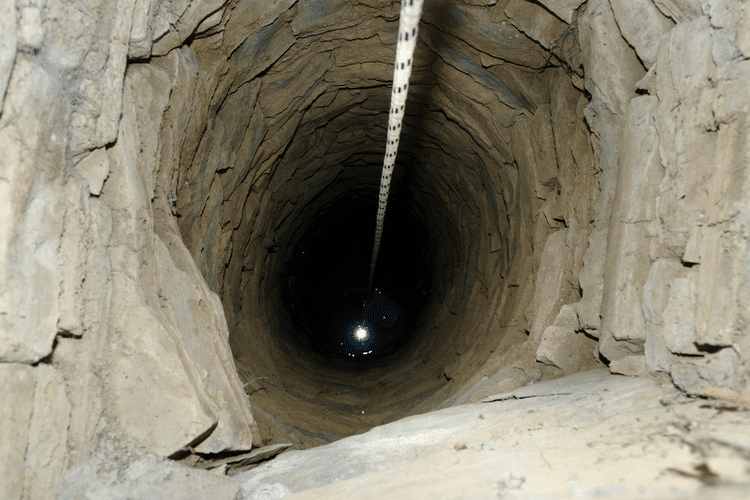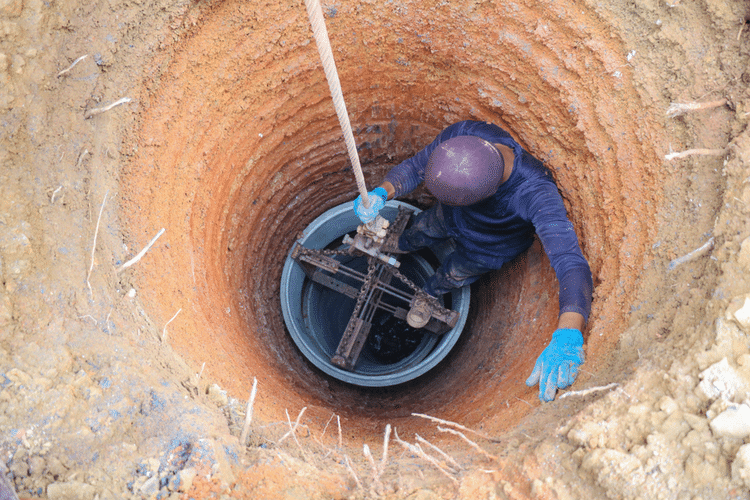How deep should a well be for drinking water? Wells should be at least 100ft deep, but this depth can reach 500ft or even 1000ft in some cases. The ideal depth depends on multiple factors such as the local geography and how deep the water table is.
How Deep Is the Average Well?
As the Water Systems Council notes, most wells are between 100ft and 800ft deep, although people tend to stop drilling around 500ft.
This range is far too broad to be the nationwide average well depth. Instead, it’s better to consider the local depth for wells. The United States Geological Survey maintains an outstanding database with this information.
Many areas of the country have water tables more than 100ft below the surface, which is why 100ft is the shortest depth for wells in most regions. The depth of the water table isn’t everything, though. As a general rule, deeper is better when digging a well because depth gives water more time to filter through rocks and get rid of contaminants. This ensures the water is less contaminated and safe for human consumption.
However, water from deep wells may also have more hard water minerals, so people tend to install water softeners. In other words, an area may only need a well 150ft deep, but people might dig down to 200, 300ft, or even more because they want a better well.

Why Shallow Wells Are a Bad Idea
The real question here is what’s the safest depth a well should be?
Shallow wells (defined as 50ft or less) are a bad idea because they may get water that picks up contaminants as it passes through surface aquifers. Possible sources of contamination include things like barnyards, sewers, septic systems, or chemicals from manufacturing facilities.
Water that is deep into the ground passes through multiple layers of rock and soil, where various biological, chemical, and physical processes remove contaminants. The result is that a sufficiently deep well has naturally purified water, while a shallow well is far more likely to contain contaminants that can cause illnesses.
Factors to Consider Before Digging a Well
Here are some factors to consider before you start digging a well.
Accessibility
Wells are more helpful if they’re dug in an accessible area. If you only have to walk out into your yard to access it, that’s a very different situation from having to walk a quarter of a mile every time you want to use it.
The ideal location for a well is usually as close to the house as possible unless factors like local geography and industrial facilities makes it impossible to do so.
Budget
According to HomeAdvisor, most wells cost between $15 and $30 per ft. A cheap well may cost around $1500 to dig, while a deep well can cost as much as $12,000. Most people will pay more than $5000 just for the drilling, which doesn’t include permits or systems like pumps and water heaters.
Local Geography
Most areas are suitable for digging wells. However, too much rock in the area can hinder the flow of water, which negatively impacts the ability of wells to function. In most areas, local governments have information on whether or not wells are suitable in particular areas.
Industrial Locations
Wells should always stay far away from industrial facilities such as manufacturing plants, chemical plants, dumps, and anything else that regularly uses chemicals. Digging a well upstream from such facilities isn’t always a good idea, either. Water may flow one way on the surface, but it could also flow in another direction underground.
Proximity To Other Wells
A well should be as far away as possible from any other wells in the area. Digging wells too close together can reduce the amount of water available to each, possibly below the point where using a well is viable.
If you expect high water demands in a specific area, it may be worth digging a single large, extra-deep well instead.
Surface Water
Surface water sources can be bad for wells. Any regular source of surface water, such as a river, may contain contaminants from agricultural, biological, or industrial sources. These are bad contaminants to have in your drinking water, so it’s best to keep wells a good distance away from them. Ideally, a well should be at least 100ft away from surface water.
Waste
Like surface water, the presence of biological waste can contaminate well water. These wastes have a high possibility of containing disease causing pathogens such as viruses and bacteria.
Special Considerations
Every well is dug at a unique spot, so the considerations for digging them can change. For example, an area may have exceptionally high water flow throughout the region, allowing wells to exist nearby without threatening each other’s water supplies. If this is the case, you don’t need to worry about proximity.
How to Dig a Well To the Required Depth
The best way to dig a well to the required depth is to hire a professional well-digging company. However, if you want to dig a deep well by yourself, you would need to get a pneumatic drill. These are available online and require buying a potent air compressor to run them. Depending on local conditions, a pneumatic drill can dig a well in days to weeks.

Regardless of how you plan to dig your well, you should check with your local government offices to learn more about the type of soil you have. The best office to talk to varies by area, but it’s usually part of an agriculture department. They can provide logs from other drillers in the area.
Remember, even experienced drillers can’t perfectly predict what to expect. However, knowing what’s common in an area will still give you a realistic idea of things to expect.
Finally, make sure to check up on any other local regulations or guidelines to get the appropriate permits before you start.
Hi Scott I live in Bixby Oklahoma. I have a wonderful well that I have been using for drinking water for 25 years. Since the well was here when I bought the house I don’t know how deep it is. I have done enough research to find out that I have an aquifier under me. How can I find out how deep it is. As you probably know Oklahoma water rights accrue to the owner. I am contemplating developing a caffeinated deep well water product. I would appreciate your thoughts about such an idea.
Hi Dudley, interesting idea about the well water product you have in mind. Good luck if you choose to pursue that! Regarding measuring depth of your well, this document has a pretty good introduction to the topic.